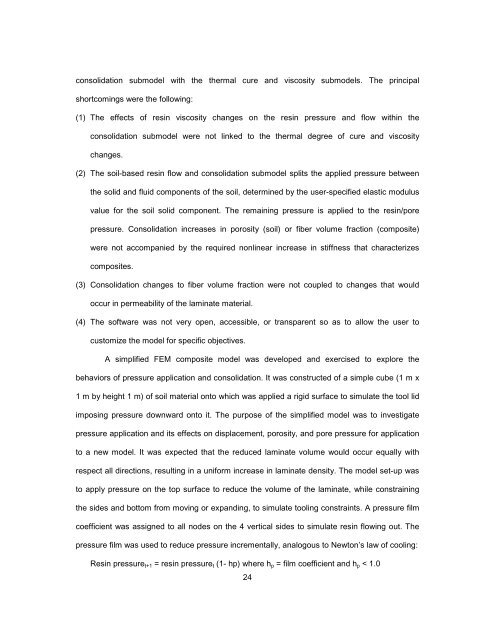TOOLED THICK COMPOSITES by ARVEN H. SAUNDERS III ...
TOOLED THICK COMPOSITES by ARVEN H. SAUNDERS III ...
TOOLED THICK COMPOSITES by ARVEN H. SAUNDERS III ...
Create successful ePaper yourself
Turn your PDF publications into a flip-book with our unique Google optimized e-Paper software.
consolidation submodel with the thermal cure and viscosity submodels. The principal<br />
shortcomings were the following:<br />
(1) The effects of resin viscosity changes on the resin pressure and flow within the<br />
consolidation submodel were not linked to the thermal degree of cure and viscosity<br />
changes.<br />
(2) The soil-based resin flow and consolidation submodel splits the applied pressure between<br />
the solid and fluid components of the soil, determined <strong>by</strong> the user-specified elastic modulus<br />
value for the soil solid component. The remaining pressure is applied to the resin/pore<br />
pressure. Consolidation increases in porosity (soil) or fiber volume fraction (composite)<br />
were not accompanied <strong>by</strong> the required nonlinear increase in stiffness that characterizes<br />
composites.<br />
(3) Consolidation changes to fiber volume fraction were not coupled to changes that would<br />
occur in permeability of the laminate material.<br />
(4) The software was not very open, accessible, or transparent so as to allow the user to<br />
customize the model for specific objectives.<br />
A simplified FEM composite model was developed and exercised to explore the<br />
behaviors of pressure application and consolidation. It was constructed of a simple cube (1 m x<br />
1 m <strong>by</strong> height 1 m) of soil material onto which was applied a rigid surface to simulate the tool lid<br />
imposing pressure downward onto it. The purpose of the simplified model was to investigate<br />
pressure application and its effects on displacement, porosity, and pore pressure for application<br />
to a new model. It was expected that the reduced laminate volume would occur equally with<br />
respect all directions, resulting in a uniform increase in laminate density. The model set-up was<br />
to apply pressure on the top surface to reduce the volume of the laminate, while constraining<br />
the sides and bottom from moving or expanding, to simulate tooling constraints. A pressure film<br />
coefficient was assigned to all nodes on the 4 vertical sides to simulate resin flowing out. The<br />
pressure film was used to reduce pressure incrementally, analogous to Newton’s law of cooling:<br />
Resin pressuret+1 = resin pressuret (1- hp) where hp = film coefficient and hp < 1.0<br />
24
















